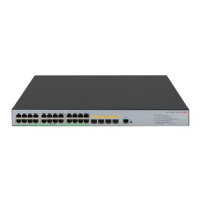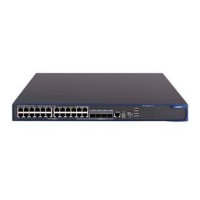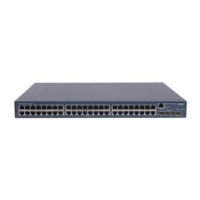32
Connecting a DC power cord to the switch
ARNING!
• H3C DC power cords are required if the –48 VDC power source is used. RPS power cords are required
if the RPS power source is used.
• Identify the positive (+) and negative (-) marks on the two wires to avoid connection mistakes.
To connect a DC power cord to the switch:
1. Wear an ESD wrist strap and make sure it makes good skin contact and is reliably grounded.
2. Correctly orient the plug at one end of the cable with the power receptacle on the power module,
and insert the plug into the power receptacle. See callout 1 in Figure 42.
If you cannot insert the plug into the recept
acle, re-orient the plug rather than use excessive force
to push it in.
3. Tighten the screws on the plug with a flat-blade screwdriver to secure the plug in the power
receptacle. See callout 2 in Figure 42.
4. Conne
ct the two wires at the other end of the power cord to a –48 VDC power source.
Figure 42 Connecting a DC power cord to the switch
Connecting the PSR150-A1
1. Wear an ESD wrist strap and make sure it makes good skin contact and is reliably grounded.
2. Attach the hooks of the bail latch (supplied with the power module) into the two holes next to the
power receptacle on the power module, and pull the bail latch leftwards (see Figure 43).
3. Connect one end of the AC power cord supplied with the power module to the power receptacle
(see callout 1 in Figure 44).
4. Pull th
e bail latch rightwards to secure the plug to the power receptacle (see callout 2 in Figure 44).
5. Connect the other end of the power cord to an AC power outlet.

